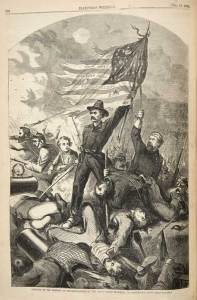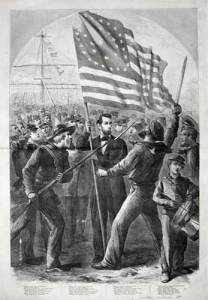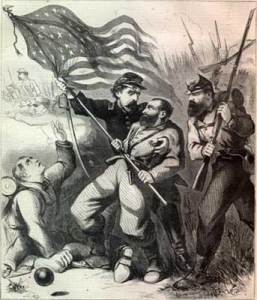Rallying ‘round American flag

A century and a half ago, during the closing months of the Civil War, Harper’s Weekly, an influential magazine, continued its coverage of the conflict – and its support of the Northern cause. Many times, that support was shown through images of the American flag.
One of the most striking shows Abraham Lincoln as a color-bearer surrounded by servicemen and a drummer boy. The drawing captures a moment that never happened. But, if not in person, then through his words, Lincoln repeatedly called on Unionists to rally ‘round the flag.

The illustration came with a poem that began: “Rally once again;/There are traitors in the camp, boys,/And pirates on the Main;/There are rebels in the front, boys,/And foes across the sea,/Who hate the proud republican/And scoff at you and me.”
The words continued with an urgent call to “Rally round the Flag, Boys!/Rally in your might;/Let the nations see how freemen/Can battle for the right.”
Again and again, Harper’s turned to such images and words to stir patriotic fervor. Articles and accompanying illustrations often focused on color-bearers, who led troops into battle, showing them the way toward the enemy and back to safety.

The color-bearers were known for their bravery. They knew their chances of survival were low because enemy muskets picked them off in the hope of confusing and scattering troops who had neither guide nor guidon to follow. Medals of Honor were often bestowed on flag-bearers because their courage amid shot and shell ranked them as leaders.
Harper’s published an account of such bravery during the Battle of Gettysburg. It was written by a surgeon with the 126th New York Volunteer Infantry. He said that “during the fight the colors had had five standard bearers, one of whom was killed, three wounded, and one escaped unharmed.”
As for the flag itself, he wrote, “Our colors came out of the fight unsullied, pierced seven times by the enemies’ balls, and torn twice by his shells. Our flag was carried into the thickest of the fight; five times its bearers were struck down, yet never for [a] moment did its folds trail in the dust. Fo[r] three long days did its faithful bearers cli[ng] to its standard upon the bloody fields,…yielding it successively only a[s] one was killed, three severely wounded and the remaining one bringing it off when victory had crowned our arms.”
